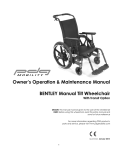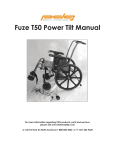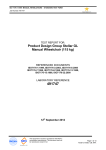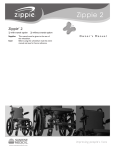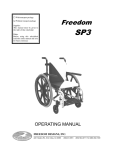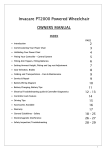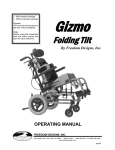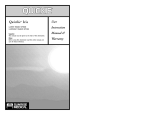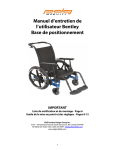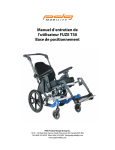Download Stellar User Manual - HME Mobility & Accessibility
Transcript
Owner’s Operation & Maintenance Manual STELLAR Manual Tilt Wheelchair DEALER: This manual must be given to the user of the wheelchair USER: Before using this wheelchair, read this entire manual and save for future reference For more information regarding PDG products, parts and service, please visit www.pdgmobility.com Class 1 Medical Device Registration CA 004986 1 Class 1 Medical Device Registration CA 004986 March 2008 WARNING Do not operate this equipment without first reading and understanding this manual. If you are unable to understand the warnings and instructions, contact a health care professional such as a doctor or therapist who is familiar with this type of product before attempting to use this equipment. Otherwise, injury or damage may result. Refer to this manual regularly for maximum safety and performance. TABLE OF CONTENTS Table of Contents ........................................................................................................................................................2 Special Notes ...............................................................................................................................................................3 Safety Summary...........................................................................................................................................................3 Safety Handling of Wheelchairs ................................................................................................................................4 Standard Features .......................................................................................................................................................8 Unpacking and Assembly ..........................................................................................................................................8 Safety Inspection Checklist........................................................................................................................................9 Troubleshooting .........................................................................................................................................................10 Maintenance .............................................................................................................................................................10 Procedures Procedure 1 - Front Riggings....................................................................................................................................11 Procedure 2 - Arms....................................................................................................................................................12 Procedure 3 - Seat and Back ..................................................................................................................................12 Procedure 4 - Rear Wheels.......................................................................................................................................13 Procedure 5 - Front Casters .....................................................................................................................................13 Procedure 6 - Seat to Floor Heights ........................................................................................................................14 Procedure 7 - Adjustable Seat Tilt...........................................................................................................................14 Procedure 8 - Adjust Gas Strut and Cable Assembly ..........................................................................................15 Procedure 9 – Motor Vehicle Use ...........................................................................................................................17 Disclosure and Warranty ..........................................................................................................................................20 2 SPECIAL NOTES WARNING/CAUTION notices as used in this manual apply to hazards or unsafe practices which could result in personal injury or property damage. NOTICE: THE INFORMATION CONTAINED IN THIS DOCUMENT IS SUBJECT TO CHANGE WITHOUT NOTICE. WHEELCHAIR USER As a manufacturer of wheelchairs, PDG endeavors to supply wheelchairs to meet many needs of the end user. However, final selection of the type of wheelchair to be used by an individual rests solely with the user and his/her health care professional capable of making such a selection. WHEELCHAIR TIE-DOWN RESTRAINTS AND SEAT RESTRAINTS PDG recommends that wheelchair users NOT be transported in vehicles of any kind while in wheelchairs. As of this date, Transport Canada, and the Department of Transportation has not approved any tie-down systems for transportation of a user in a moving vehicle of any type while in a wheelchair. It is PDG’s position that users of wheelchairs should be transferred into appropriate seating in vehicles for transportation and that use be made of the restraints made available by the auto industry. PDG can not and does not recommend any specific wheelchair transportation systems. REGARDING RESTRAINTS - SEAT BELTS - IT IS THE OBLIGATION OF THE HME DEALER, THERAPISTS AND OTHER HEALTH CARE PROFESSIONALS TO DETERMINE IF A SEATING RESTRAINT IS REQUIRED TO ENSURE THE SAFE OPERATION OF THIS EQUIPMENT BY THE USER. SERIOUS INJURY CAN OCCUR IN THE EVENT OF A FALL FROM A WHEELCHAIR. SAFETY SUMMARY OPERATING INFORMATION WARNING To determine and establish particular safety limits, practice bending, reaching and transferring activities in several combinations in the presence of a qualified health professional BEFORE attempting active use of the wheelchair. DO NOT attempt to reach objects if you have to move forward in the seat. DO NOT attempt to reach objects if you have to pick them up from the floor by reaching down between your knees. DO NOT lean over the top of the back upholstery to reach objects from behind as this may cause the wheel chair to tip over. DO NOT shift your weight or sitting position toward the direction you are reaching as the wheelchair may tip over. DO NOT tilt the wheelchair without assistance. DO NOT use an escalator to move a wheelchair between floors. Serious bodily injury may occur. DO NOT attempt to stop a moving wheelchair with the wheel locks. WHEEL LOCKS ARE NOT BRAKES. Before attempting to transfer in or out of the wheelchair, every precaution should be taken to reduce the gap distance. Turn both casters toward the object you are transferring onto. When transferring to and from the wheelchair, ALWAYS ENGAGE BOTH WHEEL LOCKS. DO NOT operate on roads, streets or highways. DO NOT climb, go up or down ramps or traverse slopes greater than 9°. DO NOT attempt to move up or down an incline with a water, ice or oil film. DO NOT attempt to ride over curbs or obstacles. Doing so may cause your wheelchair to turn over and cause bodily harm or damage to the wheelchair. DO NOT use unauthorized parts, accessories, or adapters other than those authorized by PDG. DO NOT attempt to lift wheelchair by any removable (detachable) parts. 3 DO NOT stand on the frame of the wheelchair. For products supplied with anti-tippers, anti-tippers must be attached at all times. Do not use the footplate as a platform when getting in or out of the wheelchair. ALWAYS wear your seat restraint. TIRE PRESSURE If pneumatic tires are supplied, DO NOT use your wheelchair unless it has the proper tire pressure(p.s.i.). DO NOT over inflate the tires. Failure to follow these suggestions may cause the tire to explode and cause bodily harm. Replacement of a pneumatic tire or tube MUST be performed by an authorized PDG Dealer or Qualified Technician. WEIGHT TRAINING PDG DOES NOT recommend the use of its wheelchairs as a weight training apparatus. PDG wheelchairs have NOT been designed or tested as a seat for any kind of weight training. If occupant uses said wheelchair as a weight training apparatus, PDG shall NOT be liable for bodily injury and the warranty will be voided immediately. WEIGHT LIMITATION The PDG Stellar wheelchair has a weight limitation of 350 lb. unless otherwise specified by PDG. SAFETY/HANDLING OF WHEELCHAIRS “Safety and Handling” of the wheelchair requires close attention of the wheelchair user as well as the assistant. This manual points out the most common procedures and techniques involved in the safe operation and maintenance of the wheelchair. It is important to practice and master these safe techniques until you are comfortable in maneuvering around frequently encountered architectural barriers. Use this information only as a “basic” guide. The techniques that are discussed on the following pages have been used successfully by many. Individual wheelchair users often develop skills to deal with daily living activities that may differ from those described in this manual. PDG recognizes and encourages each individual to try what works best in overcoming architectural obstacles that they may encounter. Techniques in this manual are a starting point for the new wheelchair user and assistant with “safety” as the most important consideration for all. STABILITY AND BALANCE To assure stability and proper operation of your wheelchair, you must at all times maintain proper balance. Your wheelchair has been designed to remain upright and stable during normal daily activities as long as you do not move beyond the center of gravity. Virtually all activities which involve movement in the wheelchair have an effect on the center of gravity. PDG recommends using seat restraints for additional safety while involved in activities that shift your weight. DO NOT lean forward out of the wheelchair any further than the length of the armrests. Make sure the casters are pointing in the forward position whenever you lean forward. This can be achieved by advancing the wheelchair and then reversing it in a straight line. COPING WITH EVERYDAY OBSTACLES Coping with the irritation of everyday obstacles can be alleviated somewhat by learning how to manage your wheelchair. Keep in mind your center of gravity to maintain stability/balance. A NOTE TO WHEELCHAIR ASSISTANTS When assistance to the wheelchair user is required, remember to use good body mechanics. Keep your back straight and bend your knees whenever tilting the wheelchair or traversing curbs, or other impediments. 4 Be aware of any removable (detachable) parts. These must NEVER be used for hand-held or lifting supports, as they may be inadvertently released, resulting in possible injury to the user and/or assistant(s). When learning a new assistance technique, have an experienced assistant help before attempting it alone. TILTING WARNING: DO NOT tilt the wheelchair without assistance. When tilting the wheelchair, an assistant should grasp the back of the wheelchair on a non-removable( non-detachable) part. Inform the wheelchair occupant before tilting the wheelchair and remind him/her to lean back. Be sure the occupant’s feet and hands are clear of all wheels. TILTING - CURBS: After mastering the techniques of tilting the wheelchair, use this procedure to tackle shallow curbs, short stairs, etc. METHOD 1 - WHEELCHAIR WITH STEP TUBES Apply a continuous downward motion until the balance point is achieved and the front casters clear the curb. At this point, the assistant will feel a difference in the weight distribution. Roll the wheelchair forward and slowly lower the wheelchair in one continuous movement. Do not let the wheelchair drop the last few inches to the ground. This could result in injury to the occupant. Push the wheelchair forward until the rear wheels roll up and over the curb. WHEELCHAIR WITH STEP TUBES METHOD 2 - WHEELCHAIRS WITHOUT STEP TUBES Unless the first assistant has exceptional upper body strength, it is recommended that METHOD 2 use two (2)assistants. The second assistant should be positioned at the front of the wheelchair lifting upward on a non-removable (nondetachable) part of the wheelchair frame when lifting the wheelchair and stabilizing the wheelchair when the wheelchair is being lowered to the ground. WHEELCHAIR WITHOUT STEP TUBE The first assistant should stand on the sidewalk and turn the wheelchair so that the rear wheels are against the curb. The wheelchair should be tilted back to the balance point and, in one continuous downward movement, the rear wheels should be pulled up and over the curb. DO NOT return the front casters to the ground until the wheelchair has been pulled backward far enough for the front casters to clear the edge of the curb. 5 STAIRWAYS WARNING: Do not attempt to lift a wheelchair by lifting on any removable (detachable) parts. Lifting by means of any removable(detachable) parts of a wheelchair may result in injury to the user or damage to the wheelchair. Extreme caution is advised when it is necessary to move an occupied wheelchair up or down the stairs. PDG recommends using two(2) assistants and making thorough preparations. Make sure to use ONLY secure, non-detachable parts for hand-held supports. Follow this procedure for moving the wheelchair between floors when an elevator is NOT available: 1. After the wheelchair has been tilted back to the balance point, one assistant (in the rear) backs the wheelchair up against the first step, while securely grasping a non-removable (non-detachable) part of the wheelchair for leverage. 2. The second assistant, with a firm hold on a non-detachable part of the framework, lifts the wheelchair up and over the stair and steadies the wheelchair as the first assistant places one (1) foot on the next stair and repeats STEP 1. 3. The wheelchair should not be lowered until the last stair has been negotiated and the wheelchair has been rolled away from the stairway. ESCALATORS? SORRY! DO NOT use an escalator to move a wheelchair between floors. Serious bodily injury may occur. TRANSFERRING TO AND FROM OTHER SEATS WARNING: BEFORE attempting to transfer in or out of the wheelchair, every precaution should be taken to reduce gap distance. Turn both casters toward the object you are transferring onto. Also be certain the wheel locks are engaged to help prevent wheels from moving. CAUTION - When transferring, position yourself as far back as possible in the seat. this will prevent damaged upholstery and the possibility of the wheelchair tipping forward. NOTE: This activity may be performed independently provided you have adequate mobility and upper body strength. Position the wheelchair as close as possible along side the seat to which you are transferring, with the front casters pointing toward it. Engage wheel locks. Shift body weight into seat with transfer. During independent transfer, little or no seat platform will be beneath you. Use a transfer board if at all possible. 6 FUNCTIONAL REACH FROM A WHEELCHAIR PERCENTAGE OF WEIGHT DISTRIBUTION WARNING: DO NOT attempt to reach objects if you have to move forward in the seat or pick them up frm the floor by reaching down between your knees. Many activities require the wheelchair owner to reach, bend and transfer in and out of the wheelchair. These movements will cause a change to the normal balance, the center of gravity, and the weight distribution of the wheelchair. To determine and establish your particular safety limits, practice bending, reaching and transferring activities in several combinations in the presence of a qualified health professional BEFORE attempting active use of the wheelchair. Center of Gravity shifts when reaching forward FUNCTIONAL REACH FROM A WHEELCHAIR Proper positioning is essential for your safety. When reaching, leaning, bending forward, it is important to use the front casters as a tool to maintain stability and balance. The approximate reach-limit values shown in the accompanying graph were derived on the basis of a sample of 91 male and 36 female subject wheelchair users. Note the difference between the maximum and the comfortable reach limits, a subjective but important consideration in design. REACHING, LEANING and BENDING - FORWARD Position the front casters so that they are extended as far as possible and engage wheel locks. DO NOT LEAN FORWARD OF THE ARMRESTS. REACHING, LEANING - BACKWARDS WARNING - DO NOT lean over the top of the back upholstery. This will change your center of gravity and may cause you to tip over. Position wheelchair as close as possible to the desired object. Point front casters forward to create the longest possible wheelbase. Reach back only as far as your arm will extend without changing your sitting position. 7 PDG Stellar - Standard Features 1. 2. 3. 4. 5. 6. 7. 8. 9. 10. 11. 12. 13. 14. Removable Armrest Arm Release Button Gas Strut Assembly (yellow spring) Swing Away Front Rigging Foot Plate Front Caster Tilt Activator (trigger) Rear Wheel Push Handle Back Upholstery Rear Axle Bolt Lower Frame Upper Seat Frame Lap Belt (optional) UNPACKING 1. Check for any obvious damage to the carton or its contents. If damage is evident, notify your Dealer/Carrier immediately. 2. Remove all loose packing from the carton. 3. Carefully remove all components from the carton. NOTE: Unless the PDG Stellar is to be assembled immediately, retain cartons and packing materials for use in storing the wheelchair until assembly is required. OUT OF THE BOX ASSEMBLY INSTRUCTIONS: When unpacking a new Stellar, you will need to assemble the armrests, backrest, front rigging (if applicable), connect the cable from the strut to the tilt activator (trigger) and anti-tip tubes to complete the set-up . 1. Installing the backrest - The seat frame has two bolts installed along the left and right side of the rear of the seat frame. Remove these bolts on each side and place the backrest subassembly into the back of the seat frame and replace bolts and fasten securely. To attach tilt actuator cable to the back post (trigger) follow instructions shown on page 12. 2. Installing the front rigging depends on the type of front rigging included with chair – For plug-in front rigging, push in the button on the side of the upper tube and slide into the frame until the button aligns with the hole on the frame and snaps into place. For the “swing-away” style front rigging, mount the front rigging on top of the already mounted adaptor and lock into place. 3. Install the arm assembly’s by simply sliding the arms into the slotted arm receivers on the frame. 4. If anti-tip tubes are not already installed on the chair, locate them in the box and slide them into the receivers at the back underside of the frame so that the rollers are pointing downwards. These will prevent the chair from overturning if the centre of gravity moves too far rearward and are mandatory for safety and warranty protection. IMPORTANT - With the user sitting in the chair, check to ensure the wheelchair is stable in all tilted/untilted positions before dispensing the wheelchair. INSPECTION 1. Examine exterior of the PDG Stellar for nicks, dents, scratches or other damages. Inspect all components. If damage is evident, notify your Dealer/Carrier immediately. 8 STORAGE 1. Store the repackaged PDG Stellar in a dry area. 2. DO NOT place other objects on top of the repackaged wheelchair. SAFETY INSPECTION CHECKLIST NOTE: Twice a year take your wheelchair to a qualified dealer for a thorough inspection and servicing. Regular cleaning will reveal loose or worn parts and enhance the smooth operation of your wheelchair. To operate properly and safely, your wheelchair must be cared for just like any other vehicle. Routine maintenance will extend the life and efficiency of your wheelchair. Initial adjustments should be made to suit your personal body structure and preference. Thereafter follow these maintenance procedures: ITEM INITIALLY WEEKLY X X X X MONTHLY PERIODICALLY GENERAL Wheelchair rolls straight (no excessive drag or pull to one side). Ensure all hardware is tight WHEEL LOCKS (PROCEDURE 6) Do not interfere with tires rolling. X X Pivot points free of ware and looseness. X X Wheel locks easy to engage. X X CLOTHING GUARDS Inspect for bent or protruding metal. X X Ensure all fasteners are secure X X SEAT/BACK UPHOLSTERY (PROCEDURE 3) Inspect for rips or sagging. X Inspect fastening to ensure they are secure. X X X REAR WHEELS (PROCEDURE 4) No excessive side movement or binding when lifted and spun. X Quick-release axles lock properly. X X X X FRONT CASTER (PROCEDURE 5) Inspect wheel/fork assembly for proper tension by spinning caster; caster should come to a gradual stop. Wheel bearings are clean and free of moisture. X CAUTION: Wheels and tires should be checked periodically for cracks and wear, and should be replaced when necessary. X 9 X X X X ITEM INITIALLY WEEKLY MONTHLY PERIODICALLY TIRES (PROCEDURES 5 and 6) Inspect for flat spots and wear. X If pneumatic tires, check for proper installation. X Inspect rear tires for cracks and wear. X X X X CAUTION: Wheels and tires should be checked periodically for cracks and wear, and should be replaced when necessary. CLEANING Clean and wax all parts X Clean upholstery and armrests. X Inspect axles are free from dirt, lint, etc. X Inspect tilt slides and roller bearings are free from dirt, lint, etc. X TROUBLESHOOTING CHAIR 3 WHEELS SOLUTIONS X If pneumatic, check tires for correct and equal pressure. CHAIR VEERS LEFT SLUGGISH TURN OR PERFORMANCE CASTERS FLUTTER X X X X X X X X Check caster angle. X Check that both casters contact the ground at the same time. X X X X SQUEAKS AND RATTLES LOOSE-NESS IN CHAIR CHAIR VEERS RIGHT X X Check for loose stem nuts and bolts. MAINTENANCE - FINE TUNING THE FIT… ADJUSTMENT GUIDE The following instructions are intended to provide assistance in making wheelchair adjustments. It is important to note the initial wheelchair configuration prior to making changes. When making changes, dealers and users should do so under the guidance of a health care professional who is knowledgeable of the particular limitation of the wheelchair user. Be sure that when finished, all components are properly tightened and have been completed in accordance with these instructions. DO NOT over tighten hardware attaching to the frame. This could cause damage to the frame tubing. Tools Required Philips Screw Driver Allen Keys: 1/8” 5/32”, 3/16”, 8 mm Adjustable or Open End Wrench: 7/16”, 1-1/4, 1-5/16” Socket Head Driver with socket Heads: 9/16”, 3/4”, 1-1/4” 10 CLEANING Periodic cleaning of all surfaces will help keep your wheelchair looking good and operating properly. All surfaces can be cleaned using warm water and a mild soap solution. Do not use abrasive cleaners on any surfaces. SUGGESTED MAINTENANCE PROCEDURES 1. Before using your PDG Stellar, make sure all nuts and bolts are tight. Check all parts for damage or wear and replace. Check all parts for proper adjustment. 2. Keep quick-release axles, if applicable, free of dirt and lint to ensure positive locking and proper operation. Refer to ADJUSTING THE QUICK-RELEASE AXLE or in PROCEDURE 4 of this manual. 3. If applicable, oil quick-release axles at least once (1) a month (3-in-1 oil or equivalent). WARNING: If pneumatic tires are used, do not use the wheelchair unless it has the proper tire pressure (p.s.i.). DO NOT over inflate the tires. Failure to follow these suggestions may cause the tire to explode and cause bodily harm. 4. If tires are pneumatic, recommended tire pressure is listed on the side wall of the tire. 5. The wheels and tires should be checked periodically for cracks and wear, and should be replaced when necessary at your authorized dealer or by a qualified technician. 6. For wheelchairs with handrims, periodically check handrims to ensure they are secured to the rear wheels. Operation PROCEDURE 1: FRONT RIGGING This Procedure Includes the Following: Footrest Assembly Installation Footrest Height Adjustment WARNING: After making adjustments, always make sure that parts are properly tightened BEFORE using the wheelchair. Plug-In Footrest Assembly Installation 1. To mount plug-in style front rigging, push the “button” located near the top of the footrest tube and slide into open square tube (seat rail) at front of chair. Footrest hanger will lock into position when the button ‘pops’ through hole near the front of the seat rail. 2. To release front rigging, push button (front of seat rail) and slide front rigging forward and out of the open square seat rail tube. Swing-Away Footrest Assembly Installation 1. To mount swing-away style front rigging, slide front rigging on already existing “swing-away adaptors”. The front rigging should ‘click’ and lock into place. 2. To release and swing away, push button on front rigging and push front rigging aside. Footrest Height Adjustment Height adjustment is made to the desired length with individual sitting in wheelchair with feet on foot plates. The lowest point of the foot plates should be no less than 2” from the ground or floor. 1. Remove the nut, bolt and coved washers and position the footrest assembly to a determined height. 2. Line up mounting hole and the aluminum insert in the footrest tube, reinsert the bolt and securely tighten by hand. (Be sure to replace coved washers as well) 3. Repeat the procedure for the other footrest. 11 NOTE: Check to ensure that desired front rigging adjustment does not cause pressure to legs at front of seat upholstery. Such a condition could cause injury to the occupant. WARNING: DO NOT ATTEMPT TO STAND ON FOOT PLATES. Standing on the foot plates will cause the chair to tip forward abruptly and may result in an injurious fall to the individual. DO NOT ATTEMPT to lift chair by the footrests or leg rests. These components are designed to separate from the wheelchair. FRONT RIGGING SHOULD BE REMOVED when entering or exiting from the wheelchair. PROCEDURE 2: ARMRESTS This Procedure Includes the Following: Adjusting Armrest Height Removing Armrests Armrest Pads Adjusting Armrest Height Unlock the arm by depressing the black release button on the upper front of the armrest while moving the armrest up or down. Adjust Armrest to desired height. The armrest height will ‘lock’ when the release button pops out of one of the armrest height adjustment holes. Removing Armrests Release the arm assembly by depressing the black release lever on the front of the armrest (just above the seat pan) while pulling the armrest up. Armrest Pads Check for rips or breaks. If these are present, replace immediately to maintain appearance and comfort. Armrest pad should sit flush against frame. If the pad is cracked or retaining screws are stripped, replace pad immediately. PROCEDURE 3: SEAT AND BACK This Procedure Includes the Following: Adjusting the Back Angle Adjusting the Seat Depth WARNING: After making adjustments, always make sure that parts are properly tightened BEFORE using the wheelchair. Adjusting the Back Angle The seat-to back angle may be set to 90 – 108 degrees (114 and 120 degrees requires additional hardware – please contact the dealer). Use only PDG supplied parts when changing back angle. The backrest rotates about the 2 shoulder bolts located approximately 4" above the seat pan on the backrest support bracket. The 2 bolts that extend rearward from the bottom of the backrest are used to fine-tune the angle. 1. To set seat-to-back angle at 90 - 108 degrees, first loosen both rearward facing bolts at the bottom of the backrest. 2. Move the two shoulder bolts to any one of the 4 recline select locations. 3. Retighten the shoulder bolts and the rearward facing bolts when reassembling. 4. To set seat-to-back angle at 114 or 120 degrees, remove the rearward facing bolts at the bottom of the backrest and remove the two ½” long elastomer (rubber) sleeves located between the backrest tubes and backrest support bracket and replace with 1” sleeves. Exchange bolts with 2 ¾” long bolts. Both components are supplied by PDG. Note that locknuts should be re-used no more than five (5) times to ensure locking material grips. If locknuts are worn, replace them. 12 PROCEDURE 4: REAR WHEELS This Procedure Includes the Following: Removing/Installing the Rear Wheels Adjusting the Axle Location / Wheel Position Adjustment Removing/Installing the Rear Wheels/Axles 1. Unless the product was ordered with quick-release axles, the rear wheels can be removed using a ¾” socket head and a ¾” crescent wrench. If the chair is configured using axle bolts (not quick-release), the axle bolt heads must be located on the inside of the frame with the nuts located on the outside of the rear wheel hubs. If axle bolts are installed backwards, the seat frame may hit the end of the axle bolts when attempting to tilt the chair. During assembly, tighten the axle bolts so that the rear wheels are snug but not so much that the wheels are unable to spin freely. If quick release axles have been supplied, push in the tip of the quick-release axle and pull the wheel off of the axle. 2. To reinstall the rear wheel onto the wheelchair, reverse step 1. WARNING: Make sure the detent pin and locking pins of the quick-release axle are fully released BEFORE operating the wheelchair. The locking pins MUST be protruding past the outside of the rear wheel axle receiver for a positive lock. Keep locking pins clean. Adjusting the Rear Axle position The rear wheel position may be adjusted forward or rearward. There are six bolts on each of the axle plates which hold the axle plates tight onto the lower frame. To change the position of the rear wheels, loosen these bolts slightly, and slide the rear axles forward or rearward as desired. Before re-tightening, be sure both rear axles are in the same location as measured from the rear of the lower frame members. There are measuring indicators on the bottom of the lower frame members. The antitip tubes slide into receivers at the back of the frame so that the rollers prevent the chair from overturning if the centre of gravity moves too far rearward. IMPORTANT - With the user sitting in the chair, check to ensure the wheelchair is stable in all tilted/untilted positions before dispensing the wheelchair. PROCEDURE 5: FRONT CASTERS This Procedure Includes the Following: Installing/Replacing Caster Forks Installing/Replacing Front Casters Warning: After making Adjustments, always make sure that parts are properly tightened BEFORE using the wheelchair. Installing/Replacing Caster Forks: 1. Remove the cap on top of caster housing. 2. Loosen nut on caster stem using a ¾” socket wrench. 3. Slide out caster fork assembly. 4. Reassemble by reversing steps 1-3 (Be sure bearings are replaced if removed). 5. Test the wheelchair for maneuverability. 13 Installing/Replacing Front Casters: 1. Remove bolt from front of caster housing. 2. Slide out caster. 3. Reassemble by reversing steps 1-2. 4. Test the wheelchair for maneuverability. PROCEDURE 6: SEAT-TO-FLOOR HEIGHT This Procedure Includes the Following: Adjusting Seat to Floor Height. Warning: After making Adjustments, always make sure that parts are properly replaced and tightened BEFORE using the wheelchair. Adjusting Seat to Floor Height. The seat to floor height can be adjusted from 14” to 18” depending on front caster and rear wheel combinations. An additional 2” height can be obtained by using an elevation extender kit. Refer to the Stellar spec sheet for different seat height/front caster/rear wheel combinations. 1. Remove the socket head screws located on the outside of the seat pan assembly (one screw on each side). These two screws attach the Seat Frame to the Base Frame and also act at the pivot point when the seat is tilted. 2. Reposition the Seat Frame to the desired elevation. There are three elevation choices without using frame height extenders. An additional 2" may be achieved when frame height extenders are installed. 4. Reassemble by reversing steps 1-2. 5. Remove the hex head screw located on the Base Frame, which connects the lower end of the gas strut assembly to the Base Frame. 6. Reposition the lower end of the Gas Strut Assembly to the elevation hole corresponding to the selected seat elevation. 4. Reassemble by reversing step 5. 5. Test the wheelchair to ensure the seat pan can be positioned approximately level when the gas strut is fully extended. Check to ensure all screws and nuts are assembled snugly. PROCEDURE 7: ADJUSTABLE SEAT TILT This Procedure Includes the Following: Adjusting Seat Tilt. Adjusting Seat ‘Uplift’ Force. Adjusting cable tension Warning: After making Adjustments, always make sure that parts are properly tightened BEFORE using the wheelchair. 14 Adjusting Seat Tilt: 1. To adjust the tilt angle, activate the tilting lever located on side of push handle or on the armrest, depending on how the wheelchair has been configured. Allow seat back to lower to desired level and release tilt lever. Seat should ‘lock’ at desired tilt angle. 2. Note that the tilt lever may be mounted onto the left or right side of the backrest push bar or on the left or right armrest. WARNING: When tilting chair, attendant must hold push handle securely so that seat does not drop too quickly. Adjusting Seat ‘Uplift’ Force: This procedure may be used to increase or decrease the ‘uplift’ force required to raise an occupant from a tilt position to a level seat position. Adjustment is made to both the upper and lower ends of the Gas Strut Assembly, positioning the end of the Gas Strut forward or rearward of its initial attachment point under the Seat Pan. There are many possible attachment points under the seat pan. If the wheelchair occupant feels ‘heavy’ when attempting to restore the wheelchair to a seat level position, the gas strut attachment points should be moved rearward. If the wheelchair occupant feels ‘too light’ or if the attendant has to use force to push the Seat Assembly in to tilt when activating the tilt mechanism, the gas strut attachment points should be moved forward. IMPORTANT: Be sure the strut is extended to full length before adjusting. 1. Determine whether you wish to move the gas strut forward or rearward (see above). Determine if the desired adjustment is possible (you may have already set the chair at maximum or minimum ‘lift’. 2. Carefully remove the nut and bolt from the upper end of the gas strut. Note that the spring is held in compression by a separate pin and will not extend when the bolt is removed. 3. When reassembling, be sure that strut location on the ‘lower frame strut mount’ coincides in height with the height connection on the front elevation bracket. 3. Re-assemble the gas strut ends to the desired attachment points under the Seat Pan. 4. Reinstall locknuts and tighten snugly. PROCEDURE 8: ADJUSTABLE GAS STRUT AND CABLE ASSEMBLY Adjusting Cable Tension: Once receiving and assembling the chair, you may find that the chair tilts with user in it when the trigger is not actuated or chair will not tilt when trigger is actuated. This problem may also occur over time as the cable wire ‘stretches’. A simple procedure is needed to adjust the tension of the cable wire: IMPORTANT: Before adjusting - be sure the steel ball (at bottom end of cable wire) is inserted into actuating lever slot and cable is properly attached to trigger. 1. If the chair does not tilt when trigger is actuated - the cable wire is too loose and needs to be tightened. To do so, remove the rubber sleeve above the gas strut housing on the cable and turn the ‘tightening nut’ so less thread is showing above the nut. 2. If the chair tilts without actuation – the cable tension is too tight and needs loosening. Reverse the procedure from above, making more thread showing above the ‘tightening nut’. 15 Installing the Gas Strut Actuator Cable 1. Fit metal cable-end into hole on trigger. 3. Push plastic parts together Æ Å until they 'click' in place 2. Feed cable through to the front of the trigger 4. Clip cable onto back post using plastic clips provided. 5. Attach cable wire onto the strut, slide steel ball through slot on lever (so ball is underside of the lever). 16 Setup of 16”/24” Rear Wheel Ant-tippers Axle positions are noted by the location of the rear edge of the axle plate on the ruled sticker on the frame. The hole position on the anti-tip tube is described by the diagram below. Stellar Axle Position Anti-tip Wheel Position 3 ½” – 4 ½” 4 4 ¾” – 6 ¾” 5 7” – 8” 6 (20" or 24" rear wheels only) (20" or 24" rear wheels only) Bentley 1 2 Axle Position Anti-tip Wheel Position 3 ½” – 4 ¼” 5 4 ½” – 6 ¾” 6 3 4 5 6 The extra positions (1 through 3) can be used to make the chair more stable, but it will reduce the caster clearance when tipped backwards. PROCEDURE 9: MOTOR VEHICLE USE WARNING Identify whether your chair has been manufactured with the Transit Tie-Down System (TTDS). If your chair is NOT equipped with the Transit Tie-Down System (TTDS), this wheelchair DOES NOT meet federal standards for motor vehicle seating. 1. NEVER let anyone sit in this chair while in a moving vehicle. 2. ALWAYS secure the rider with proper vehicle restraints. In an accident or sudden stop the rider may be thrown from the chair. Wheelchair seatbelts will not prevent this and further injury may result from the belts or straps. 3. NEVER transport this chair in the front seat of a vehicle. It may shift and interfere with the driver. 4. ALWAYS secure this chair so that it cannot roll or shift. 5. Do not use any chair that has been involved in a motor vehicle accident. 17 If your chair is equipped with the Transit Tie-Down System (TTDS): 1. If possible and feasible, the rider should transfer to the Original Equipment Manufacturer vehicle seat and use the vehicle restraint. 2. Use only Wheelchair Tie Down and Occupant Restraint Systems (WTORS) which meet the requirements of SAE J2249 Recommended Practice – Wheelchair Tie Down and Occupant Restraint Systems For Use in Motor Vehicles. Do not use WTORS designed to rely on the wheelchair structure to transfer occupant restraint loads to the vehicle. 3. The rider must not weigh more than 250 lbs. 4. The wheelchair has been dynamically tested in a forward –facing mode for a 30 mph frontal impact test. The wheelchair must be forward facing during transport. 5. In order to reduce the potential of injury to vehicle occupants, wheelchair-mounted accessories, such as trays and respiratory equipment should be removed and secured separately. 6. Postural supports and positioning devices should not be relied on for occupant restraint. 7. Do not alter or substitute wheelchair frame parts, components or seating. 8. The figures below show the locations of the wheelchair securement points, front and back. Stellar Front Tiedown Stellar Rear Tiedown 9. Use only with Wheelchair Tie Down and Occupant Restraint Systems (WTORS) that have been installed in accordance with the manufacturer’s instructions and SAE J2249. 10. Attach WTORS to securement points in accordance with the manufacturer’s instructions and SAE J2249. 11. Attach occupant restraints in accordance with the manufacturer’s instructions and SAE J2249. 12. Sudden stops or impacts can structurally damage your chair. Chairs involved in such incidents should be replaced. If you fail to heed these warnings, damage to your chair, a fall, tip-overs or loss of control may occur and cause severe injury to the rider or others. CONTACTING YOUR SUPPLIER TO OBTAIN SERVICE PDG has trained customer service representatives in many locations. To find your nearest Customer Service Center, visit our web site at www.pdgmobility.com and click on CONTACTS. If you are uncertain about which CONTACT is most appropriate for your needs, contact PDG directly using telephone, fax, or e-mail contact information. Supply the serial number from the product you are attempting to service and we will be happy to inform you of the supplier who initially provided your product. SPECIAL NOTE – DAMAGE REQUIRING SERVICE BY QUALIFIED SERVICE AGENT In some circumstances it may be required that your wheelchair be returned to a Qualified Service Agent for repairs. If any of the following conditions are observed, the wheelchair must be serviced by a Qualified Service Agent; - Any part of the frame is cracked or broken - Any weld is cracked or broken Always contact your Service Agent prior to sending a wheelchair for repairs. For safe and secure shipping, the wheelchair must be boxed or fastened to a pallet to ensure it does not become damaged during shipping. Service agent will provide specific instructions for packaging and shipping your wheelchair. Alternatively, Qualified Service Agent may arrange for pick-up. 18 PERFORMANCE ATTRIBUTES OF THE TEST WHEELCHAIR Test Method AS 3696.1 Test Title Determination of static stability Relevant Wheelchair Type Disclosure Manual All results meet at least the minimum performance requirements of AS 3695 Manual Stable on a slope of 10° or labelled in accordance with Clause 6.1 Pass (100kg dummy) with locked brakes in the fore direction >15°/0° with locked brakes in the aft direction >15°/>15° with unlocked brakes in the aft direction >15°/0° with locked brakes in the transverse direction >15° AS3696.3 AS3696.8 Determination of the efficiency of brakes Manual Static, impact & fatigue strength Manual Parking brakes hold on a slope of 10° Pass (100kg dummy) Pass ( 100kg) DIMENSIONAL ATTRIBUTES OF THE TEST WHEELCHAIR Test Method AS 3696.5 ISO 7176-7 Test Title Determination of all overall dimensions, mass and turning space Determination of seating dimensions Relevant Wheelchair Type Manual Manual Results Length 1150 mm Length without footrest 900 mm Width 720 mm Folded length N/A Folded width N/A Folded height N/A Mass 33.4 kg Turn around width 1235 mm Seat plane angle 1.5° Effective seat length Maximum seat width Seat surface height Backrest angle Backrest height 19 475 mm 450 mm 455 mm 10° 552 mm LIMITED WARRANTY PLEASE NOTE: THE WARRANTY BELOW HAS BEEN DRAFTED TO COMPLY WITH FEDERAL LAW APPLICABLE TO PRODUCTS MANUFACTURED AFTER JULY 4, 1975. This warranty is extended only to the original purchaser/user of our products. This warranty gives you specific legal rights and you may also have other legal rights, which vary from state to state. PDG warrants its product, except for the seat cushion (which is not warranted), to be free from defects in materials and workmanship for a period of one (1) year from date of purchase. The side frames and cross-members are warranted for the lifetime of the original purchaser/user. If within such warranty period any such product shall be proven to be defective, such product shall be repaired or replaced, at PDG’s option. This warranty does not include any labor or shipping charges incurred in replacement part installation or repair of any such product. PDG’s sole obligation and your exclusive remedy under this warranty shall be limited to such repair and/or replacement. For warranty service, please contact the dealer from whom you purchased your PDG product. In the event you do not receive satisfactory warranty service, please write directly to PDG at the address on the back cover page, provide dealer’s name, address, and date of purchase, indicate nature of the defect and, if the product is serialized, indicate the serial number. Do not return products to our factory without our prior consent. Limitations and exclusions: the foregoing warranty shall not apply to serial numbered products if the serial number has been removed or defaced, products subjected to negligence, accident, improper operation, maintenance or storage, products modified without PDG’s express written consent including, but not limited to, modification through the use of unauthorized parts or attachments; products damaged by reason of repairs made to any component without the specific consent of PDG, or to a product damaged by circumstances beyond PDG’s control, and such evaluation will be solely determined by PDG. The warranty shall not apply to problems arising from normal wear or failure to adhere to these instructions. The foregoing express warranty is exclusive and in lieu of any other warranties whatsoever, whether express or implied, including the implied warranties of merchantability and fitness for a particular purpose, and the sole remedy for violations of any warranty whatsoever, shall be limited to repair or replacement of the defective product pursuant to the terms contained herein. The application of any implied warranty whatsoever shall not extend beyond the duration of the express warranty provided herein. The manufacturer shall not be liable for any consequential or incidental damages whatsoever. This warranty shall be extended to comply with state/provincial laws and requirements. 20 THIS WARRANTY SHALL BE EXTENDED TO COMPLY WITH STATE/PROVINCIAL LAWS AND REQUIREMENTS. PRODUCT DESIGN GROUP INC. Ph: (604) 323-9220 Fax: (604) 323-9097 E-mail: [email protected] 21 www.pdgmobility.com





















